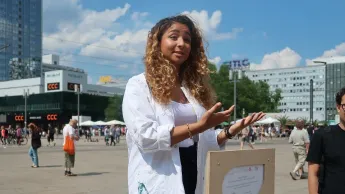Soapbox Science – strengthening gender equality in science
- 2021-10-04
- Eva Lindner
- Comment

Soapbox Science is an interactive event in a public space aimed primarily at raising the profile of women scientists and their research and promoting gender equity in academia. The scientists stand on a soapbox and present their work by entering into a conversation with their audience, asking questions and encouraging people to participate. By doing so, they familiarise the general public with the issues in question, inspire society and act as role models for girls and young women.
How does a Soapbox Science event work?
Building on the tradition of Speaker’s Corner in London’s Hyde Park, a speaker stands on a (soap) box in a public square, park or street and presents her research. This can be, for instance, in the fields of biomechanics, immunology, psycholinguistics or other disciplines. Passers-by who stop and listen stand in a semi-circle around the scientist. The minimal difference in height between the researcher and the audience means the exchange is intentionally ‘eye-to-eye’. Public space thus serves as a place of learning and debate.
What is special about Soapbox Science?
The format deliberately attempts to counter the preconception that research is performed by grey-haired, male scientists in ivory towers. Soapbox Science introduces female scientists and non-binary researchers into people’s everyday lives, dispelling clichés and providing society with low-threshold access to science. Speakers completely dispense with power point presentations, a lab or handouts. By means of simple experiments or hands-on activities, they make their research intelligible and encourage people to ask questions.
Which requirements need to be met?
A permit may be needed to hold an event in a park, on a street or in a square. Posters, flyers and social media can be used to convey information to the target group. Soapbox Science at its London headquarters offers free training for female scientists, giving them tips for their presentations. For the event itself, all that is needed is a (soap) box and at least four female scientists. Additional publicity can be generated by inviting members of the press. You can register a soapbox event with a date and location .
Which target groups are suitable for the format?
The concept is suitable for a group of children, pupils or adults with no prior knowledge.
Duration: approx. 15 min per lecture // in total approx. 2–3 hours
Special tip
In Germany, there are local groups in Berlin and Munich that organise Soapbox Science events.
Get to know other formats of science communication on the Alumniportal Deutschland
One topic, numerous workshop participants and even more ideas – in a World Café, everyone sits around tables to exchange ideas, get to know one other and rapidly arrive at collaborative results by means of a creative method. From our series on the most effective formats of science communication.
20 slides, 20 seconds: a maximum of 6:40 minutes to cover everything. Presenters at Pecha Kucha events give insights e.g. into topics of science, art, or architecture. The most important rule: there must be no room for boredom.
